Tyler Seguin's shooting to be a Star

This story appeared in the Nov. 23, 2015, issue of SPORTS ILLUSTRATED. To subscribe, click here.
On a mid-July afternoon during the busiest summer of his life, Tyler Seguin received a text message revealing the location of a private party hosted by Derek Jeter. The announcement, kept secret to keep paparazzi away, directed Seguin to an intimate, closed-off patio atop a Los Angeles hotel. There, at a gathering thrown by Jeter’s media venture, The Players’ Tribune, mingled pro athletes in town for the ESPYs the next night. No outside guests were allowed, and Seguin, the Stars’ gifted center, was the only hockey player present. He had been awed when he met icons like Sidney Crosby and Alex Ovechkin at his first NHL All-Star Game in 2012, but this was something else entirely. He had never met so many luminaries from so many other sports at one time. Here he was shaking hands with Kobe Bryant, LeBron James and the Captain.
The party ended after a few hours, everyone peeling off for other events around the city, but the experience stuck with Seguin long after he returned to his off-season home in downtown Toronto. He had tried watching how these superstars acted, all of them versatile in their talents, branded in their image, famous beyond their sports. He admired—even envied—what he saw. “Jeter was probably my biggest, like, whoa,” Seguin says. “It’s crazy because you think these guys are like gods, but they still put on their pants the same way we do. They’re just people, but it’s how they carry themselves.”
• POWER RANKINGS: Dangerous Stars grab top spot for first time
Then again, it’s not as if Seguin was an undeserving guest on that terrace. The second pick in the NHL draft in 2010, he kissed the Stanley Cup with the Bruins less than a year later, at 19. Last May he won gold with Team Canada at the IIHF world championships, leading the tournament with nine goals. And now, in his third season with Dallas, he shares the league lead in points (26) with Chicago’s Patrick Kane and had nine goals at week’s end. Since 2013–14, only two NHL players—Crosby and Seguin’s teammate Jamie Benn—have more points, and no one has averaged more first assists or points per 60 minutes. Boyishly handsome and the owner of the most dangerous slap shot his coach has ever seen, Seguin, now 23, makes for a perfectly marketable combination: the inked up, all-world sniper with a disarming smile.
“He’s cognizant of who he is, what he wants to do and how he wants to portray himself,” his agent, Ian Pulver, says. “It cuts against the grain sometimes, the traditional Canadian way of being. Some people don’t like it, find it a little too edgy. [But] he’s exactly what the sport needs.”
Stars' Seguin gives birthday gift to fan, then scores hat trick vs. Bruins
In the buttoned-up NHL, where -attention-deflecting humility is championed, Seguin consciously embraces an alternate image—that of a selfie-snapping superstar for the millennial age.
“He’s not your typical hockey player,” friend and Flyers defenseman Michael Del Zotto says. “He’s got that edge to him. He’s got the two sleeve tattoos [and a] kind of playboy mentality.”
When he wasn’t fishing with friends in lakeside Ontario or working out five days a week inside a windowless concrete room in Toronto, Seguin spent his summer on the move. He filmed several cameos for a sequel to the 2012 hockey movie Goon, hurling f-bombs at actor Seann William Scott. He partied at the actual Playboy Mansion—dress code: sleepwear—and posed naked for ESPN’s The Body Issue. After Team Canada’s training camp in Vienna and the worlds in Prague, he vacationed with friends in Amsterdam, London and Paris, where he took a selfie with the Eiffel Tower. Though the monument shouldn’t feel special. At this point, it is not unreasonable to suggest that Seguin has smiled into the cellphones of half of Dallas’s hockey fans.
Nor is it unreasonable to believe that Seguin can indeed transcend the NHL and become, in the words of his manager, John Walters, “the next David Beckham or the Cristiano Ronaldo of hockey.” To help him get there, Seguin retains a Miami-based publicist, who represents Gisele Bunchen; an endorsement agent in New York City whose only other sports client is Tom Brady; and a financial manager who oversees his $5.75 million annual salary. The members of Team Seguin, as they jokingly call themselves, work toward a mission their boss explains this way: “It’s always going to be hockey first, it’s always going to be training first, but why not do everything else, too?” Maybe he’ll start a clothing line, or buy a junior team, or open an Italian restaurant—all ideas he and Walters have discussed.
•Stars getting all they hoped for from Patrick Sharp and Johnny Oduya
“The sky’s the limit,” Del Zotto says before adding, “It all depends how it goes on the ice.”
For a charismatic bachelor literally living in the former home of Dallas’s last hockey superstar, for the top-line center on the Western Conference’s No. 1 team, the merging of sports and celebrity can be thorny. “Very, very tricky,” Seguin says, sitting in the team lounge after a recent practice. When asked why, he pauses, as though the answer should be obvious. “I mean. . . ,” he laughs. “Look at my history.”
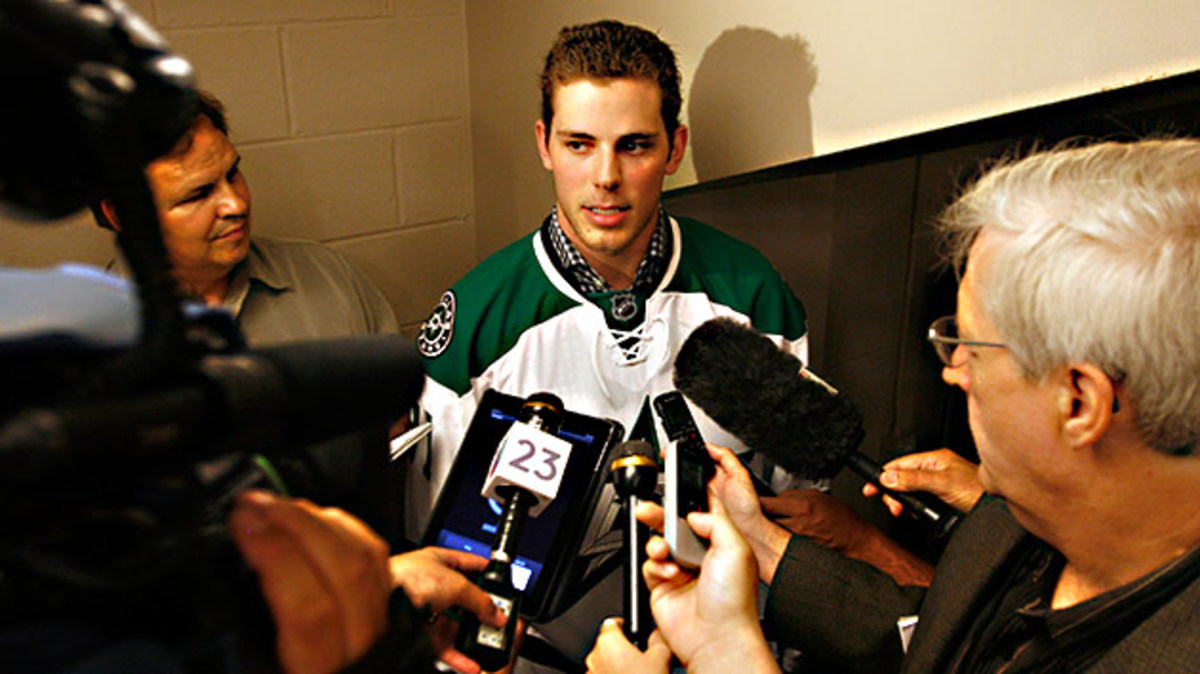
The new face of the franchise was in town for the first time, so Stars GM Jim Nill invited Seguin to dinner the night before his introductory press conference in July 2013. They talked about moving him from the wing, where he played in Boston, to center, about working on face-offs and playing with Benn. And while Nill says he wasn’t concerned about the stories and rumors that followed Seguin out of Boston, he was interested enough to hear the player tell his side.
As Seguin was making the eight-hour drive from Boston to Toronto on July 5—he had learned about the trade while partying on Cape Cod the day before—the Boston Herald released a story that labeled him a “problem child.” According to the paper, the Bruins’ front office was concerned that he had spent too many late nights about town, was spotted too many times dancing shirtless on bars. To that point, Seguin’s public transgressions had included a homophobic tweet in April 2013 that he later apologized for and a missed morning skate (he overslept) during his second season, relatively minor blips on the news spectrum.
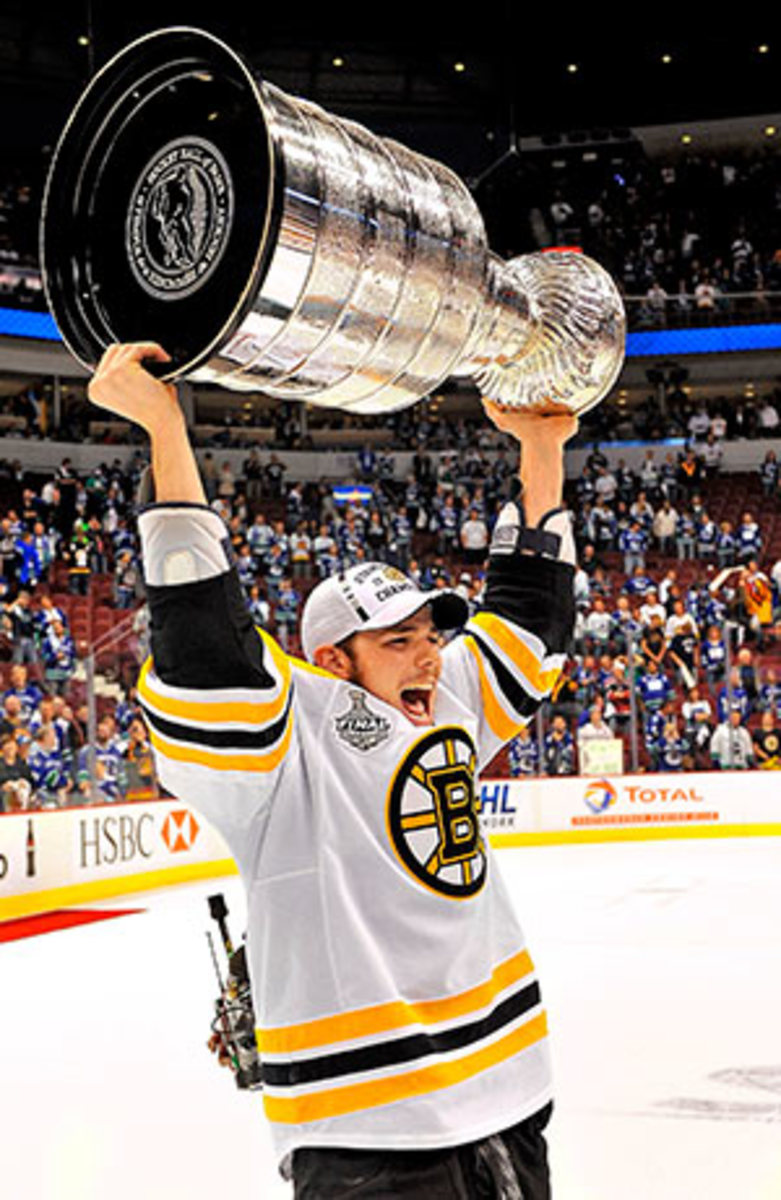
Then-GM Peter Chiarelli declared at a news conference announcing the trade that jettisoning Seguin “was nothing about extracurricular activities,” and a former Bruins official says now that excessive partying “was not the reason we traded Tyler.” But three months after the deal an episode of Behind the B, a Bruins-produced documentary series, captured Chiarelli and other top brass discussing whether to trade Seguin with surprising candor. Director of player personnel Scott Bradley raised Seguin’s one goal in 22 postseason games and questioned his toughness and enthusiasm for puck battles. Before echoing those concerns, team president Cam Neely said, “There’s a couple issues from my perspective. There’s the off-ice and on-ice.” The implication dangled: If the cap-strapped Bruins were troubled only by Seguin’s play, they might have showed more patience with the player they had showered with a six-year, $34.5 million extension less than a year earlier.
Rookie Mattias Janmark happened while the Stars made other plans
Nill pulled off the seven-player stunner just nine weeks after he took over as the Stars’ GM, capping a franchise-wide overhaul following a fifth straight season without a playoff berth. Dallas’s logo and jerseys had been redesigned in a color called Victory Green. Nill, formerly Detroit’s assistant GM, and coach Lindy Ruff (from Buffalo) had come aboard, forming an affable and experienced tandem on the hockey side. “I knew I was right in the middle of a Day One rebuild, reborn organization,” Seguin says. “I was either going to thrive in it, or I was going to fail, and that was going to be it for me. That was a big point in my career.”
Seguin, for his part, could strengthen Dallas’s offense. In 2011–12 he led the Bruins with 67 points despite averaging less than 17 minutes on the ice. When he met with Nill, Seguin asked for film of Benn to study, which impressed his new boss. Nill reminded Seguin that Dallas was adding him to its core, and with that came certain expectations. “He was a young guy,” Nill says. “He just needed some guidance. Everybody needs some guidance.”
He summed up his advice by telling the budding star, “Never change.” In other words, be the 11-year-old who arrived to his first meeting with Walters wearing a white T-shirt, a tucked-in Kenyon Martin Nuggets jersey and hair with blond, frosted tips. Or the Seguin who has a microscopic stick figure inked inside his armpit hair because the tattoo artist said that was the most painful spot. Be the Seguin who last summer would spend seven hours on his Body Issue shoot, “straight-up naked the whole time.” For one set of photos he rode an ice resurfacer and licked a fruit Popsicle. In another, his personal popsicle hid behind a yellow rubber ducky.
• Jeremy Roenick: 'Hockey is not as brutally mean as it used to be'
Sitting at his desk at the Stars’ practice facility last month, Ruff hopped between praise for and caution about a player he believes can “dominate the league.” Ruff fondly recalled the previous night, when Seguin cleanly won two critical offensive zone face-offs that helped set up Patrick Sharp’s tying goal against the Canucks. But, the coach also says, “his personality is prone to making a big mistake. He might take a picture or say something and all of a sudden . . .” Ruff bangs his hand into his fist. “. . . there’s a tweet or a social media blog or something, and you’ll go, Tyler, did you really say that? In the spur of the moment, he might’ve. That’s his personality. But that sometimes isn’t a bad thing. He’s expressing himself. Just try to say the right thing and do the right thing.”
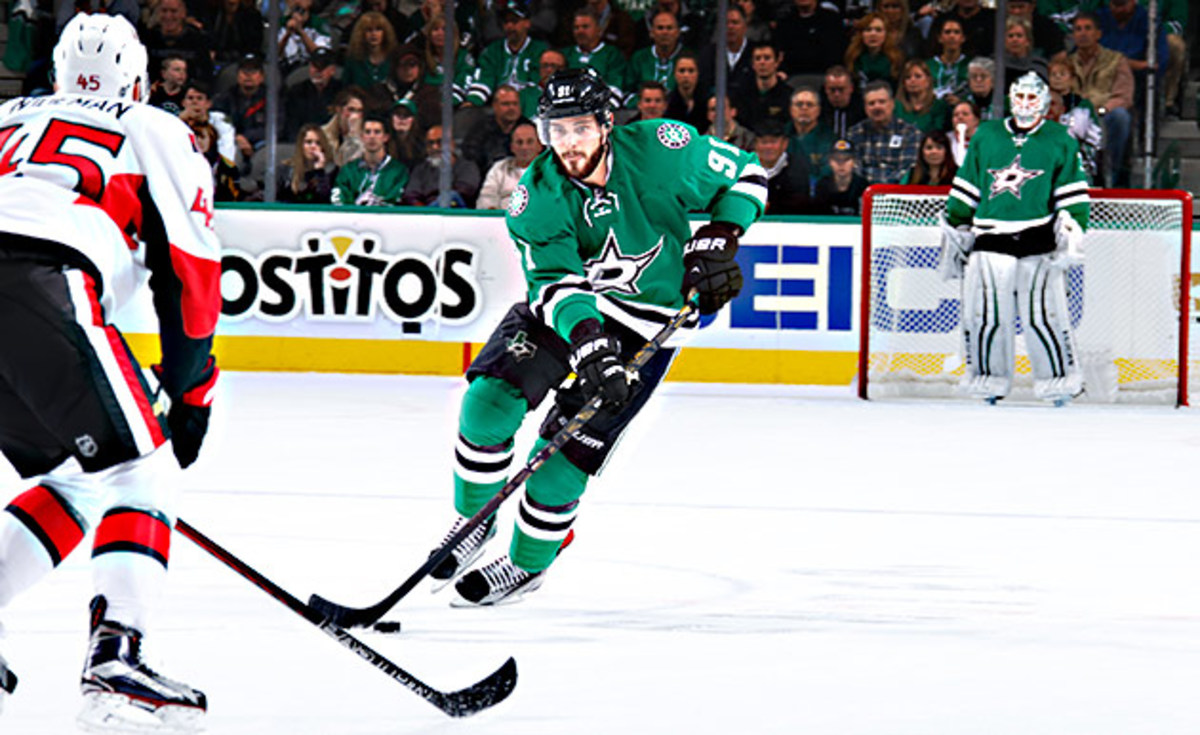
Last winter, around the time his Players’ Tribune article about his split from Boston went live—“Moving On,” the headline read—Seguin decided to buy a house in Dallas. He visited more than a dozen places but couldn’t shake the memory of the French country mansion on Mimosa Lane, better suited for a traditional family than a single hockey player: 7,250 square feet with a fire pit, outdoor bar, cabana, wine cellar and swimming pool. Plus, the seller was Stars Hall of Famer Mike Modano.
Dallas Stars score big with Jumbotron jokes that go viral
After Seguin made his $1.925 million purchase, the symbolism—-substitute house key for franchise torch—escaped- no one, least of all Brad Alberts, the Stars’ chief revenue officer. Since Seguin’s arrival, Alberts notes, full-season ticket equivalents have almost doubled, and more than 3,000 Seguin 91 jerseys have been sold at the team store, which will soon hawk hats with his personal TS logo. “Seguin Selfies”—yes, his brand has coopted duck faces too—are now a pregame tradition at American Airlines Center, where Seguin takes a picture with a lucky fan after warmups. And so it is that Alberts compares Seguin with the franchise’s greatest player: “He’s charismatic, good-looking, übertalented. He reminds me of Modano in a lot of ways.”
Seguin has his mellow tendencies too. Whenever he had a free weekend last summer, he drove two hours from Toronto to Georgian Bay, to a friend’s cottage on an island reachable only by water taxi. They rose before dawn, cleaned whatever they caught, napped until the afternoon, ate dinner and returned to the water by dusk, when the walleye nipped best. He went eight or nine times before reporting to training camp. “I find it way more fun than even going out or anything,” he says.
He understands how improbable this sounds. “It’s an automatic assumption that people have,” he says. “At this point people are still talking, and that’s on their own time. I’m happy where I am. Being here [in Dallas] is one of the best things to ever happen to me.”
So he works, strengthening the foundation upon which everything else will be built. Matt Nichol, his off-season trainer, often modified exercises because Seguin blistered his hands from shooting too many pucks. This summer he dead-lifted 400 pounds for the first time. Seguin maintains a body-fat percentage under five, and he has abs Nichol describes as “GQ18-pack.” And on the morning he left for the ESPYs, Seguin awoke around 4 a.m. to, as he calls it, J.J. Watt.
• How an NHL team’s system affects a player’s performance
A few months earlier, when the Texans’ siege engine had been in Toronto for a commercial shoot, he requested a predawn session with Nichol. “I’m not even sure if that’s early,” the trainer says of Watt’s 4:30 a.m. ask. “I think that’s still late.” But Watt showed up and ripped through the workout, and a new verb was born. Matty, can we J.J. Watt on Friday? And thus, hours before rubbing elbows with Jeter, Seguin J.J. Watted a personal-best five pull-ups with 90 pounds dangling from his waist.
As one former Boston teammate puts it, “If you’re doing [endorsements and -appearances], you better be able to back it up. If he’s not performing, then guys would be all over him. . . . But he’s f---ing performing. He’s earning his f---ing money.”
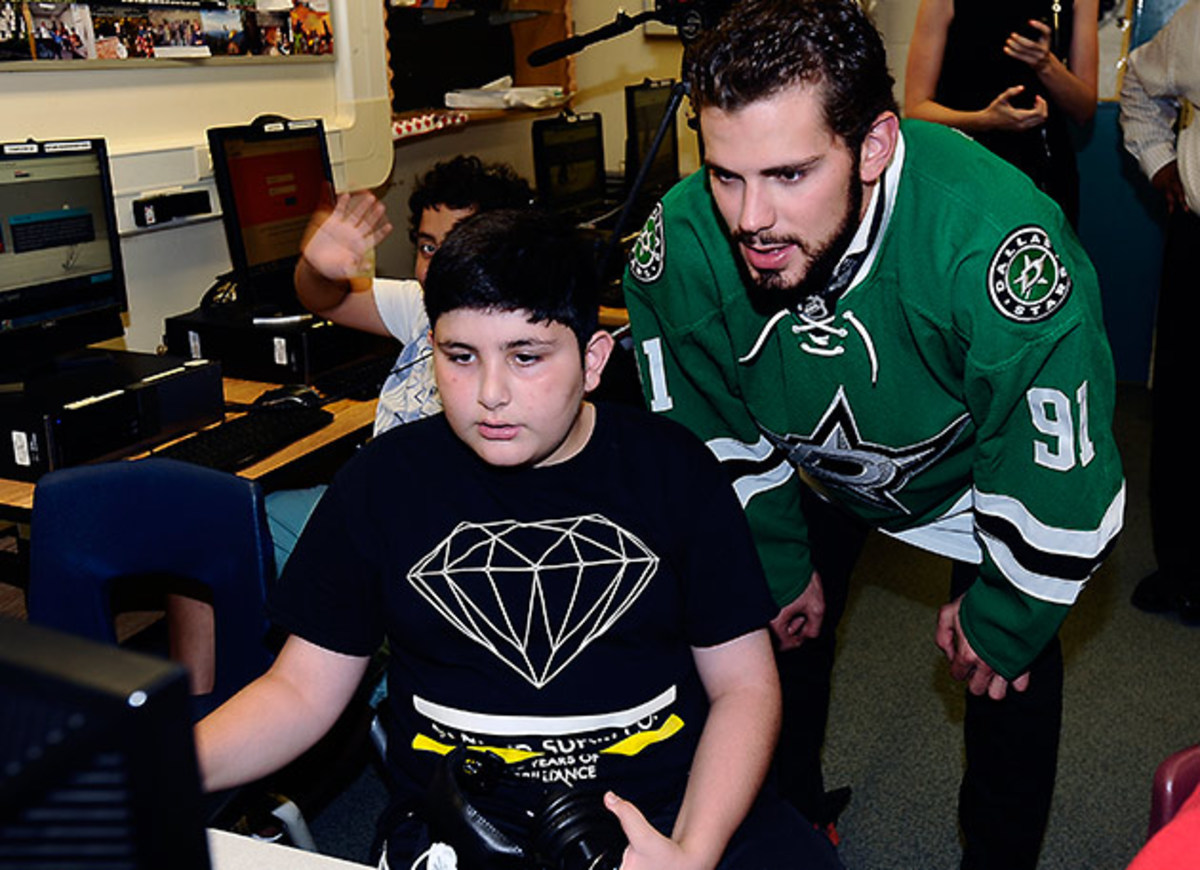
On Halloween afternoon, with the Sharks in town, Americans Airlines Center was crawling with zombies, some of them dressed in Seguin jerseys. That evening the undead witnessed a ninth Dallas victory in 11 games—the team’s best start in nine years. A few days later Seguin pummeled his old Bruins in Boston with a hat trick, his sixth with Dallas. He would also make a fan cry with joy by tossing her a puck on her 16th birthday.
“He’s a melting pot,” Demers says. “When the off-ice and the on-ice collides, when you can manage that marketability and still perform on the ice, it’s a dangerous combo.”
In “Moving On,” Seguin wrote that he felt the Bruins “gave up on me too early,” but after the initial shock faded, he found the quieter rhythm of Dallas a better fit. There were parks for his dogs and malls he could wander without someone posting his location on Twitter. He is famous here, busy here, but not overwhelmingly so.
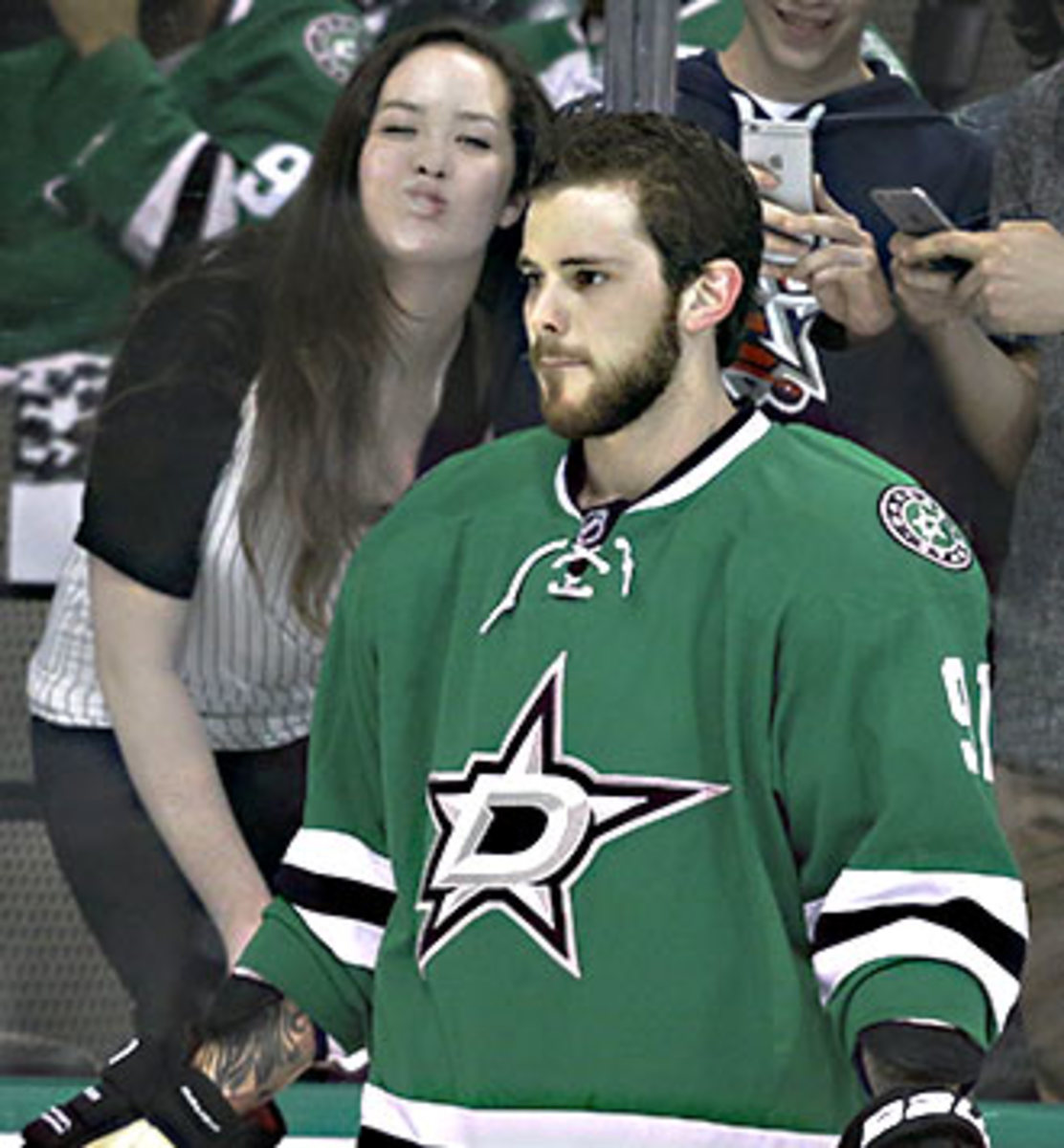
He fills the free hours with calls to Team Seguin and receives monthly email updates. He has a mortgage and kitchen countertops he chose himself. He has a foundation, which hosts sled hockey players in his private suite for every home game. He has the last two lines of William Ernest Henley’s “Invictus” tattooed on his right arm: I am the master of my fate/I am the captain of my soul.
“I want to build some type of brand or empire for my future so when I get away from the game, I can be like these other guys, like Derek Jeter, and have events and still be connected somehow,” Seguin says. “There is going to be life after hockey.”
But when he’s on the ice, hockey is life. A few hours before the Stars took down San Jose 5–3, Seguin looped around as warmups ended, helmetless and hair slicked back. The house lights dimmed as he stepped through the bench door, last off the ice as usual. Before disappearing down the tunnel, he stopped and knelt beside a young fan near the bench. He flashed that disarming smile—click—for another Seguin Selfie.
